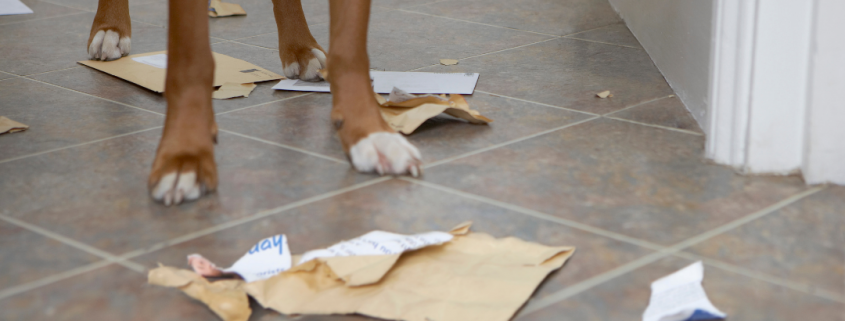Ask Crystal: Destructive Behavior and Learning New Manners
Welcome to “Ask Crystal,” where you can ask your pet behavior questions! You can submit your question for Crystal at the bottom of the page!
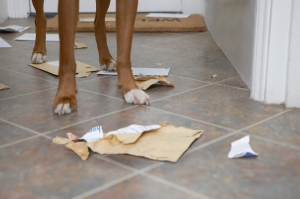
Dear Crystal,
I just adopted a 4-year-old lab mix from a local shelter. I am not sure of his past history because he was surrendered. He is a very good dog. He is very lovable, understands a lot of commands and is housebroken. I do have 2 issues that I am not sure how to handle. The first is when I leave him alone for a while he destroys things. The other is that he barks and cries when he sees other dogs. Any suggestions???
Sincerely,
New dog owner
Dear New,
Congratulations on your new family member! I personally think that age for dogs is pretty much the best age for dogs. They are usually housebroken, have a nice energy level and their personality is set by that time. It sounds like you got a good one!
Destructive chewing can be caused by different things. It is important to determine the cause of the behavior in order to get to the root of the behavior. The majority of destructive behavior is caused by boredom and excess energy in adult dogs. Another cause of destructive behavior can be anxiety. We need to look at the dog’s behavior in other contexts to find out what the cause of the behavior is.
A challenge of adopting an adult dog is that you don’t often don’t have that history. I am a big proponent of taking a through history when a dog is surrendered by an owner so that the adopter can have a better idea of what the dog needs. We do see adult dogs that don’t seem to understand what to chew and what not to. That is often because whoever had them as a puppy did not closely monitor their behavior and redirect them on to appropriate items. These dogs often have inappropriate chew preferences.
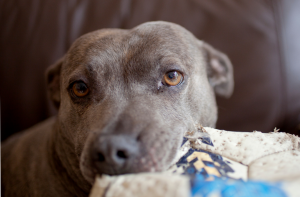 Start by looking at when the dog is chewing inappropriately. If the dog never chews in your presence and only when you are gone, that may tell us something. It could be that the dog was yelled at for chewing on items so thus learned to only chew them when the owner is not present. Another possible cause could be that the dog is just bored being left alone. It can also be a sign that the dog is feeling anxious about being left alone.
Start by looking at when the dog is chewing inappropriately. If the dog never chews in your presence and only when you are gone, that may tell us something. It could be that the dog was yelled at for chewing on items so thus learned to only chew them when the owner is not present. Another possible cause could be that the dog is just bored being left alone. It can also be a sign that the dog is feeling anxious about being left alone.
Consider setting up a camera in the room that the dog is in to determine possible causes by seeing when the behavior occurs. Is the dog destructive only when you are absent? How long does it take the behavior to begin? Are there other anxious behaviors being observed?
Dogs that have generalized anxiety often use chewing as a way to self-soothe themselves. Does the dog display anxious behavior when you are present? This may include pacing, whining, barking, shaking, and drooling, among other behaviors. These dogs may need a behavior plan to address the root of anxious behavior. It may be that he is anxious because he is new to you and your house and it will improve with time as well.
Separation anxiety can be a cause of destructive behavior in dogs. Dogs with separation anxiety show anxiety at the first signs of their owner getting ready to leave. When the owner leaves, they demonstrate extreme stress-related behaviors such as barking, drooling, panting, pacing, and destructive behaviors which focus on exit points such as doors and windows. Dogs with this issue are very attached to an owner. They will follow that owner from room to room and display frantic greeting when the owner returns. If you feel your dog may have separation anxiety, you should consult a Certified Professional Behavior Consultant. Separation anxiety is a complicated behavior problem which requires professional assistance to create a behavior plan. Locate a certified trainer here.
Dogs that don’t receive enough exercise and mental stimulation may demonstrate destructive behaviors. Stress and excess energy levels can lead to destructive behavior. Exercise reduces both of these. A walk around the block is not going to be sufficient exercise for young dogs. Add in structured exercise a few times a day to burn off some energy. Teach your dog to fetch or play tug-of-war with rules. Hire a dog walker to come midday and give your dog a nice long walk. If you have private land with some space, walk your dog on a long line until they can be trusted off leash. Consider dog daycare a couple times a week if your dog is dog-friendly.
Mental energy is important too. Food-dispensing toys as the primary means of feeding is one of the easiest ways to burn mental energy in a dog. The Kong Wobbler, Buster Cube and Roll-A-Treat ball are great ways to occupy your dog’s mind. You may want to leave food toys hidden around the house to occupy your dog. Training is also a great way to burn mental energy. It sounds like he may be pretty trainable if he already knows some cues. Training is also a fantastic way to bond with your new dog.
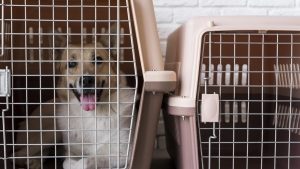 When you are not home, crate the dog or keep him in a small dog-proof room. When you are home, the dog should always be under direct supervision which means someone should always be able to see them. Baby gates, freestanding dog pens, and training tethers may be used to keep the dog confined to the area. Teach your dog a positive interrupter cue to interrupt inappropriate chewing and redirect to an appropriate toy. I like to use uh-oh as an interrupter as it is pretty hard to say that angrily. The point is just to get the dog away from the item and redirect them onto something appropriate.
When you are not home, crate the dog or keep him in a small dog-proof room. When you are home, the dog should always be under direct supervision which means someone should always be able to see them. Baby gates, freestanding dog pens, and training tethers may be used to keep the dog confined to the area. Teach your dog a positive interrupter cue to interrupt inappropriate chewing and redirect to an appropriate toy. I like to use uh-oh as an interrupter as it is pretty hard to say that angrily. The point is just to get the dog away from the item and redirect them onto something appropriate.
Keep a large supply of appropriate chew toys on hand. In general, appropriate inedible chew toys are made of hard rubber. Edible chew toys include bully sticks, Himalayan yak sticks, and rawhide-free chews. You can fill Kongs and sterilized bones with food and freeze them for a long-lasting chew. These also provide an opportunity for the dog to lick, which is soothing. If you can consistently provide your pup with a supply of desirable chew toys, he will develop a preference for chewing on these toys. Supervise your dog with any new toys. Regularly check the condition of any chew toys and discard them when they begin to show signs of wear and tear.
Barking and crying at the sight of other dogs can be caused by frustration at not being able to reach the other dog. It can also be caused by a negative association with other dogs. Defensive reactivity is the dog that is afraid and wants the other dog to go away. Offensive leash reactivity is when the dog that doesn’t like other dogs and wants to attack them. It can be hard to tell what the motive is. I would suggest getting him evaluated by a dog day care to see if he likes to play with other dogs. If he seems really friendly and wants to play with other dogs, it could be caused by frustration.
This behavior is often caused by owners who allow their dog to greet every dog he sees on leash. Personally, I do not let my dogs greet other dogs on walks. It creates an expectation that the dog is going to be able to say hello to every dog he sees which he just not the case. It could also be that he was raised somewhere dogs didn’t wear leashes and were allowed to run up to each other.
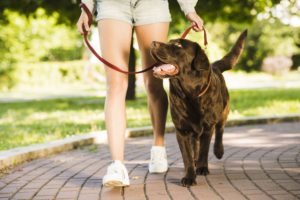 Management is where we always want to start our training program. Find ways to avoid him seeing other dogs on leash so that he is not practicing this behavior and also to keep his stress levels down. For reactive dogs that means finding times and places to walk where you won’t encounter a lot of other dogs. You can also duck behind cars or trees or walk different ways if you see a dog coming. Find it is a great distraction technique to use when another dog is coming and you want to keep your dog from seeing it. You can train a maneuver to get your dog moving in another direction without dragging him or scaring him by training the Emergency U-Turn or Walk Away.
Management is where we always want to start our training program. Find ways to avoid him seeing other dogs on leash so that he is not practicing this behavior and also to keep his stress levels down. For reactive dogs that means finding times and places to walk where you won’t encounter a lot of other dogs. You can also duck behind cars or trees or walk different ways if you see a dog coming. Find it is a great distraction technique to use when another dog is coming and you want to keep your dog from seeing it. You can train a maneuver to get your dog moving in another direction without dragging him or scaring him by training the Emergency U-Turn or Walk Away.
We often find that these dogs have low frustration tolerance in general or poor impulse control. It is extremely helpful in many situations to have a variety of impulse control cues trained. I personally find them to be the most useful cues. These include leave it, stay and wait. Basically, cues that teach the dog if they can just be still and wait, they will be allowed to get what they want.
You can also use sit as a default behavior for those times when the dog doesn’t know what else to do. We do this by reinforcing sit a lot so that the dog has a high reinforcement history for it. That means when the dog offers a sit, reward it and also ask him to sit and reward it frequently. Once the dog gets the hang of what sitting means, start to increase the duration of the sits before giving the reward.
If your dog is frustrated reactive, you can use the fact that he really wants to go say hello to the other dogs as a training motivator. Start at his threshold distance. This is where he can notice the other dog but not become frantic or excited. As long as your dog remains calm, slowly move forward. The moment that he begins to get excited, turn and walk around to whatever distance he needs to calm down. As you repeat this procedure many times, the dog should begin to realize that his calm behavior allows him to move closer. Once he is able to make it all the way up to the other dog, take a calm parallel walk with the other dog. We don’t want to let the dog immediately start playing with the other dog because that will reinforce the idea that he gets to play with every dog he walks up to. Save off-leash play time for a little bit later in the walk. If the dog is getting more and more frustrated, you may want to use a different technique for this dog.
Reactivity can be very frustrating and complicated to work on alone so I really recommend hiring a force free, reward-based trainer to help coach you as you go along. We all get stuck sometimes and it really helps to have another pair of eyes especially ones that have been trained on what to look for and how to respond. Good luck and happy training your new pup!
Until next time,
Crystal

